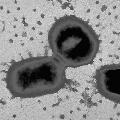



|
| This project is collaborated between The Forsyth Institute (TFI) and The Institute for Genomic Research (TIGR), and is funded by National Institute of Dental and Craniofacial Research (NIDCR) |
|
|
|||||||||||||||||||||||||
Genetic tools available for the study of P. gingivalisP. gingivalis can be manipulated genetically using mating and vector systems developed for other pathogenic Bacteroides spp. (reviewed by Salyers and Shoemaker, 1992; and Macrina and Smith, 1993). TetQ and erythromycin- clindamycin resistance genes from B. fragilis can be used as selectable markers (Nikolich et al., 1992; Tally et al., 1982). Cloned genes can be transferred from Escherichia coli by mating using the IncP plasmid R751 to mobilize the IncQ suicide vector pJRD215 (Davison et al., 1987). This strategy has been used by several groups for transferring mutant genes to construct knockout mutants, and for mutagenesis using the Bacteroides transposon Tn4351 (Rasmussen et al., 1987; Genco et al., 1993; Genco et al., 1995a; Gharbia and Shah, 1993; Lepine et al.1996; Park and McBride, 1993; Schoemaker et al., 1986; Yoshimoto et al., 1993). |
||||
|
This page is created and maintained by Drs. Margaret Duncan, Floyd Dewhirst, and Tsute Chen, Department of Molecular Genetics, The Forsyth Institute . Last modified on 02/20/2002 Copyright 2000, 2001, 2002 by The Forsyth Institute |